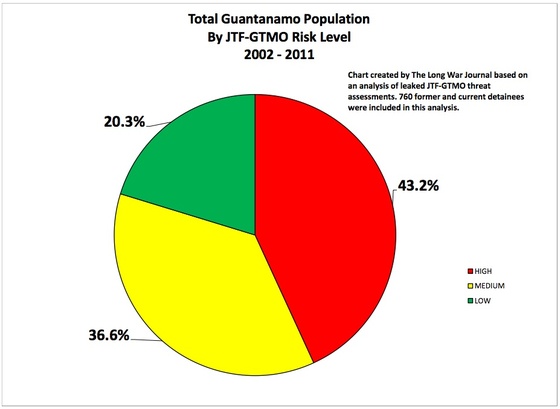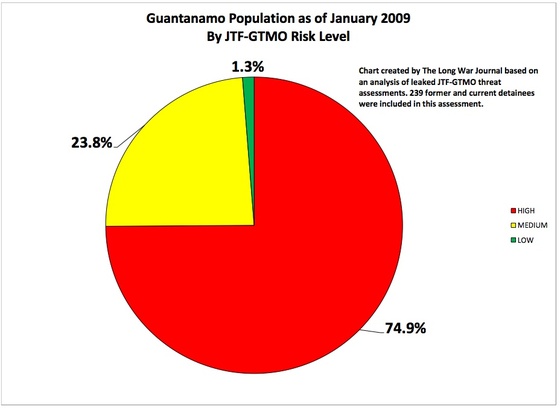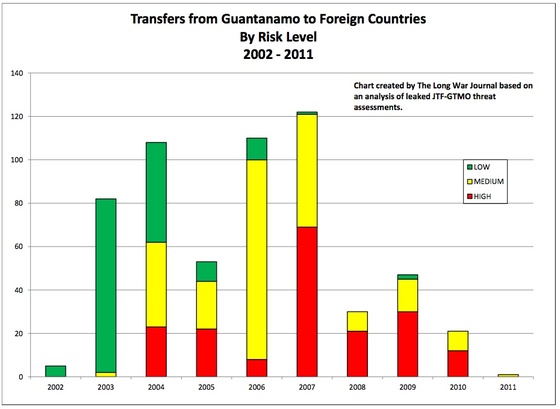The Obama administration has released a list of 55 Guantanamo detainees who were approved for transfer by the Guantanamo Bay Review Task Force. The task force, which was authorized by President Obama as one of his first acts in office, completed its work in January 2010. The Obama administration has worked to resettle many of the detainees the task force approved for transfer, but the detainees on the newly-disclosed list remain at Guantanamo.
Before the task force was authorized in January 2009, Joint Task Force Guantanamo (JTF-GTMO) had previously assessed all of the detainees held in Cuba. JTF-GTMO’s threat assessments for 760 current and former detainees have been leaked online. (Approximately 167 detainees remain in custody at this time.)
The Long War Journal has matched those threat assessments to the 55 detainees on the task force’s list.
JTF-GTMO determined that 34 of the 55 detainees on the newly-released list were “high risk(s)” who are “likely to pose a threat to the US, its interests, and allies” if freed from custody. One detainee was deemed a “medium to high risk.”
JTF-GTMO assessed that 19 of the 55 detainees are “medium risk(s)” who “may pose a threat to the US, its interests, and allies.”
Just one of the 55 detainees was assessed to be a “low risk, due to his medical condition.”
Ultimately, the task force’s recommendations differed from JTF-GTMO’s in at least 37 of the 55 cases. JTF-GTMO recommended that all 34 “high risk” detainees and 3 “medium risk” detainees remain in the Defense Department’s custody, whereas the task force approved them for transfer.
Prior to the task force’s creation, JTF-GTMO also disagreed with civilian authorities in the Bush administration on some transfer decisions. (JTF-GTMO made recommendations on transfers to authorities in the Defense Department, who then made decisions on how to treat individual cases.)
Of the 55 detainees on the list, 24 are Yemeni. The Obama administration suspended transfers to Yemen after the attempted Christmas Day 2009 attack on a Detroit-bound airliner. That plot was traced back to al Qaeda in the Arabian Peninsula (AQAP), a terrorist organization that is staffed by a significant number of ex-Gitmo detainees.
A “high risk” population
That a majority of the detainees on the newly-released list were once determined to be “high risk” is not surprising given how the Guantanamo population evolved over time.
The Long War Journal has matched the leaked JTF-GTMO threat assessments to 760 former and current Guantanamo detainees. (Threat assessments are not available for 19 other detainees.) The pie chart below represents this total population of detainees previously or currently held at Guantanamo.
JTF-GTMO determined that 328 detainees (43.2 percent) were “high risk”; 278 (36.6 percent) were “medium risk”; and 154 (20.3 percent) were “low risk.”
A second pie chart shows the population of detainees that remained at Guantanamo as of January 2009 — that is, the detainee population the task force evaluated. By that time, the detainee population was overwhelmingly “high risk,” based on an analysis of JTF-GTMO’s threat assessments.
The Long War Journal matched 239 JTF-GTMO threat assessments to detainees held at Guantanamo as of January 2009. At that time, 179 (74.9 percent) were deemed “high risk”; 57 (23.8 percent) “medium risk”; and the remaining 3 (1.3 percent) were determined to be “low risk.”
A third chart shows how, over time, US authorities began to transfer more “medium” and “high” risk detainees in order to empty many of the Guantanamo cells.
At first, the overwhelming majority of detainees transferred or released were “low risk” candidates. No “high risk” detainees were transferred in 2002 or 2003. From 2004 to 2006, however, the US government began transferring significant numbers of “high risk” detainees. Then, in 2007, 69 “high risk” detainees were transferred — more than the previous years combined.
As with other intelligence analyses, JTF-GTMO’s threat assessments are not, of course, perfect. Some detainees were mistakenly deemed “low risk” only to go on to become terrorist commanders after their release. Others were determined to be “high risk,” but apparently have not resurfaced as terrorists or insurgents upon their release from American custody.
Still, it is evident that the US government has accepted more overall risk in its transfer decisions over time. And there is a direct link between the acceptance of more risk and recidivism.
For example, the “high risk” detainees transferred in 2007 include terrorists who went on to assume leadership positions in al Qaeda in the Arabian Peninsula, the Taliban, and al Qaeda-affiliated groups elsewhere.
“Approved for transfer,” not “cleared for release”
It has been widely reported that the 55 detainees on the task force’s list have been “cleared for release.” But this is not true. Instead, almost all of the detainees in question, if not all of them, have been “approved for transfer.” The task force explained the difference in its final report, which was filed in January 2010.
The task force explained that the guidelines it operated under “provided that a detainee should be deemed eligible for release if he does not pose an identifiable threat to the national security of the United States.” However, “[o]ther than the 17 Chinese Uighur detainees, who were approved for ‘transfer or release,’ no detainees were approved for ‘release’ during the course of the review.” [emphasis added]
The Task Force distinguished between detainee “releases” and “transfers.”
Release “is used to mean release from confinement without the need for continuing security measures in the receiving country.” Transfer “is used to mean release from confinement subject to appropriate security measures.”
The distinction is an important one, as almost every one of the detainees on the list (again, if not all) is supposed to be “subject to appropriate security measures” upon transfer. In practice, even these security measures frequently fail to mitigate the threat posed by former Guantanamo detainees.











7 Comments
Just for kix maybe Obama can go ahead & add Charlie Manson & Sirhan Sirhan to the list
My question is transfers to where?? The local mall?? I have to assume transfer means to another country with security agreements etc…maybe I missed it.
If anyone thinks that President Obama is just openly letting insurgent and terrorist leaders go, you are drunk on kool-aid. The military loves to do this kind of stuff and then blame the commander-in-chief. It happened to President Bush and now they’re doing it to President Obama. It’s not like the president makes these micro-decisions. Stop all the political blustering.
@Ghost S
and yet Obama campaigned on closing GitMo & relocating terrorists to domestic locales. By the way it was ‘The House’ not a bunch of Military brass that short circuited the decision making process that you so cavalierly claimed the C&C to be a victim of.
@Ghost Soldier: You might be confused as to the process since Obama took office in 2009. The Guantanamo Review Task Force was created by an Obama Executive Order and was directed by AG Holder and comprised of individuals from the DOJ, State Department, Homeland Security as well as individuals from the DoD. It was a very political enterprise from the start. The detainees in Bill’s report above are being processed under the recommendations of that political Review Task Force, and not under the auspices of the SOUTHCOM JTF-GITMO as they were prior to Obama’s EO in January 2009. At least that’s my understanding.
What drives this insane desire to send these terror turkeys back to the islamic paradises where they are highly likely to be turned right around to kill more of us Yankee infidel dogs?
The numbers of recycled terrorists is much higher than those that stay home growing cabbages.
Recidivism in the terrorist turkey business is extremely high – high enough to really suggest that it would be best to terminate these critters as a safety measure.
I am sure the folks that the kill in the future would probably second my suggestion were that possible.
Well hell they let Omar hammami live, I will not vote for this administration. Bill is this target dead yet or is he CIA? I will go and kill Omar and Al Sadar myself!